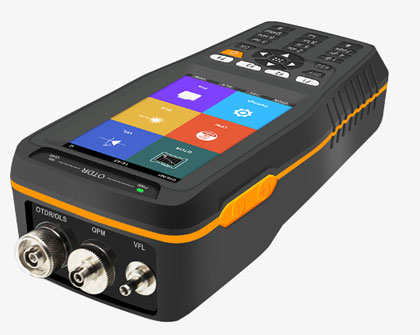Handheld smart OTDR fiber tester with backlit display, compatible with connector type FC/PC, SC/PC, wavelength 1310/1550nm, which is a cost-effective but powerful multi-functional fiber tester.

Smart OTDR tester, 4-inch IPS Display
- One-button operation with clear visibility of test data.
- A smart handheld OTDR fiber tester is integrated with a visual fault location system, which can easily detect the fault location in the dead zone.
- Fiber optic tester has good dustproof, waterproof, and shockproof ability, suitable for field maintenance.
Work. - Large capacity battery, long working time, suitable for long time fieldwork.
- Sisco optical time domain reflectometer is suitable for FTTx and access network engineering construction and maintenance fault location.
Application
OTDR (optical time domain reflectometer) uses the backward scattered light generated when the light propagates in the fiber to obtain attenuation information, which can be used to measure fiber attenuation, splice loss, fiber fault location and understand the loss distribution along the length of the fiber, etc. OTDR tester is an essential tool in fiber optic cable construction, maintenance, and monitoring.

| OTDR | |
| Model | SISCO-OTDR-FC290 |
| Wavelength | 1310/1550nm |
| Dynamic Range | 22/20dB |
| Measure Distances | 0-60km |
| Fiber Type | SM |
| Type of Fiber | 9/125um Single-mode optical fiber |
| Connector Type | UPC/APC |
| Peak Value of Laser | >=30mW |
| UOM of Measuremen | Meter, Feet, Mile |
| Dead Zone of Reflection Event | 2m |
| Dead Zone of Attenuation Even | 12m |
| Accuracy Distance (Reflection Event) | About ±(1m+2 *10(-4)* distance) |
| Number of Test Records Saved | 200 |
| Power Supply | 7.4V Li-ion Battery 4400mAH |
| Temperature | Operate: -5~50, Store: -10~60 |
| Humidity | 0~85% (Non-condensing) |
| Weight | 300g |
| Certificate | CE |
| Visual Fault Locator | |
| Wavelength | 650nm |
| VFL Output Power | >=10m |
| Mode | CW, 1Hz, 2Hz |
| Fiber Type | SM/MM |
| Optical Power Meter | |
| Measurement Range | -70~+10 dBm, -50~+26 dBm |
| Wavelength Range | 800~1650nm |
| Calibrated Wavelength | 850nm, 1300nm, 1310nm, 1490nm, 1550nm, 1625nm (Other wavelengths can be customized) |
| Accuracy | <±3% (-10dBm、22℃) |
| Resolution | Linearity: 0.1%, Non-linearity: 0.01dBm |
| Connector | Changeable FC/PC SC/PC, (ST as Optional) |
| Optical Light Source | |
| Emitter | FP-LD |
| Wavelength | 1310/1550nm |
| Output Power | ≥-5dBm |
| Output Stability | ±0.04@20℃@15min |
| Modulation | CW/270Hz/1KHz/2KHz |
| Fiber Type | SM |
Accessories
| NO. | Name | Quantity |
| Standard Accessories | ||
| 1 | OTDR with FC/UPC Connector | 1 |
| 2 | AC/DC Charger | 1 |
| 3 | CD (Software and User Manual) | 1 |
| 4 | User Manual | 1 |
| 5 | Test Report | 1 |
| 6 | Softcase | 1 |
| 7 | SC Connector for OTDR Port | 1 |
| 8 | SC Connector for OPM port | 1 |
| 9 | Operationtips Card | 2 |
| Optional Accessories | ||
| 1 | ST Connector for OTDR Port | 1 |
| 2 | ST Connector for OPM Port | 1 |
Thank you for buying industrial test and measurement equipment on SISCO.com, all products sold by SISCO and the partner cover a 12 months warranty, effective from the date of receiving the products.
What is covered?
SISCO is responsible for providing free spare parts, and free technical support to assist the customer to repair the defective products until the problem is solved.
What is not covered?
- Product purchased from anyone other than a SISCO store or a SISCO authorized reseller.
- Expendable parts.
- Routine cleaning or normal cosmetic and mechanical wear.
- Damage from misuse, abuse or neglect.
- Damage from use of parts other than SISCO approved.
- Damage from use outside the product’s usage or storage parameters.
- Damage from use of parts not sold by SISCO.
- Damage from modification or incorporation into other products.
- Damage from repair or replacement of warranted parts by a service provider other than a SISCO authorized service provider.
- Damage caused by the application environment not meeting the product usage requirements and the failure to perform preventive maintenance.
Q1: What is an OTDR used for?
A1: OTDR is a fiber optic instrument used to characterize, troubleshoot and maintain optical communication networks. OTDR testing is performed by transmitting and analyzing pulsed laser light through an optical fiber.
Q2: What is fiber loss?
A2: Optical fiber loss is the attenuation per unit length of optical fiber in dB/km, the level of fiber loss directly affects the transmission distance or the distance between relay stations, therefore, understanding and reducing the loss of optical fiber is of great practical significance for fiber optic communication.
Q3: What is an optical time domain reflectometer?
A3: The optical time domain reflectometer is a fiber optic tester used to test the characteristics of optical communication networks. OTDR is designed to detect, locate and measure events at any location on a fiber optic link. OTDR requires access to only one end of the link and works in a manner similar to a one-dimensional radar system. By providing graphical trace characteristics of the fiber under test, the user can obtain a graphical representation of the entire fiber link.
Tips: How does the OTDR tester work?
The development of OTDR is based on the optical principle and Rayleigh scattering and Fresnel reflection to do, Rayleigh scattering is due to the formation of the properties of the fiber itself, Fresnel reflection is due to the formation of mechanical connection and breakage, OTDR itself is light source emits a certain intensity and wavelength of the light signal, under the influence of Rayleigh scattering and Fresnel reflection, light back to the OTDR itself, after the photoelectric converter and noise amplifier and The light is returned to the OTDR itself, and the image and list are displayed on the screen through the optical converter, noise amplifier, and image processing components.

